
How To Diagnose Scaphoid Fractures | Physical Therapy Evaluation
In today's episode we go over How To Diagnose Scaphoid Fractures | Physical Therapy Evaluation:
As physical therapists, we know the importance of accurate diagnosis when it comes to treating our patients. When it comes to scaphoid fractures, a proper diagnosis is crucial for ensuring proper treatment and avoiding long-term complications. No one likes a dead bone in their wrist and if we don't make the right call we may be leading our patients down a bad path...
The scaphoid bone is a small bone located in the wrist, and it can be easily fractured during a fall or other trauma. However, these fractures are often difficult to detect and can be easily missed on an X-ray. Folks training in the gym place a lot of stress on the wrist during movements like bench press, olympic lifts and during handstand skills. Often times the wrist becomes pretty irritated.
If a scaphoid fracture is not properly diagnosed and treated, it can lead to long-term complications such as chronic pain, reduced grip strength, and arthritis.
That's why it's important for physical therapists to be aware of the signs and symptoms of a scaphoid fracture, and to work closely with physicians to ensure an accurate diagnosis.
Symptoms of a scaphoid fracture may include pain and swelling in the wrist, particularly in the area near the thumb. Patients may also experience difficulty gripping or holding objects.
If a scaphoid fracture is suspected, it's important to refer for medical attention and imaging right away. X-rays may not always show the fracture, so additional imaging such as a CT scan or MRI may be necessary.
So if you suspect a scaphoid fracture it's time to refer your patient to a physician...
Check out the video below to see how I like to evaluate patients for scaphoid fractures:
By working closely with physicians to ensure an accurate diagnosis and providing appropriate treatment, physical therapists can help patients with scaphoid fractures avoid long-term complications and return to training as quickly and safely as possible
No dead wrist bones!
- Dan Pope PT, DPT, OCS, CSCS
Show Notes / Relevant Articles:
- FPF Mini Course - 7 Reasons Why Injuries Happen in the Gym and What to do About it
- Physical Therapy Treatment for Wrist Pain | Olympic Lifting, CrossFit, Powerlifting
- The Best Physical Therapy Exercises for Golfer's Elbow [Medial Epicondylalgia]
- Evidence Based Guide to Tennis Elbow | Lateral Epicondylalgia, Epicondylitis, Tendinitis, Tendinopathy
Want to support me and decide topics for future episodes? Click HERE to sign up for FPF "Insiders" for just a dollar. You'll gain access to 100+ webinars, e-books and complete guides. Plus, you'll get private access to the "Insiders" Facebook group where you can have all of your questions answered by me.
Looking for other ways to support me that are 100% free?
- Like, comment and share on youtube, facebook and instagram
- Leave a 5-star review on apple podcasts
Thank you!
Dan Pope DPT, OCS, CSCS
References:
- Bäcker HC, Wu CH, Strauch RJ. Systematic Review of Diagnosis of Clinically Suspected Scaphoid Fractures. J Wrist Surg. 2020 Feb;9(1):81-89. doi: 10.1055/s-0039-1693147. Epub 2019 Jul 21. PMID: 32025360; PMCID: PMC7000269.
- Mallee WH, Henny EP, van Dijk CN, Kamminga SP, van Enst WA, Kloen P. Clinical diagnostic evaluation for scaphoid fractures: a systematic review and meta-analysis. J Hand Surg Am. 2014 Sep;39(9):1683-1691.e2. doi: 10.1016/j.jhsa.2014.06.004. Epub 2014 Aug 1. PMID: 25091335.
